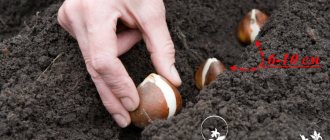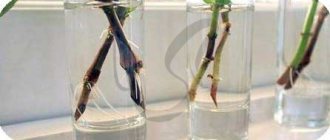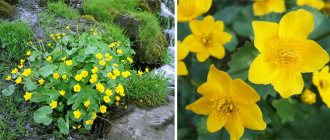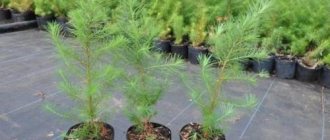Snowdrop is a famous small-bulbous perennial, otherwise called galanthus. Botanically, this plant is closely related to narcissus, but blooms much earlier. Where and when snowdrops appear, what varieties they come in, and interesting facts associated with these flowers will be discussed below.
When do snowdrops appear?
In botany there is the concept of “ephemeroids”. It denotes a group of perennial plants with an ultra-short growing season, which falls in early spring or autumn. Snowdrops are ephemeroids with early spring growing season.
The name tells about the time of appearance of snowdrops. They begin to grow when the snow cover melts. At this time, the awakening of the bulbs and the growth of leaves begins. Flowering occurs when the soil is almost completely free of snow and the first insects begin to fly. In central Russia, galanthus bloom in March. In regions located in a more severe climate, it shifts to April.
This life strategy of snowdrops is due to the fact that these plants strive to complete the growing season during the period when competition for sunlight is lowest. Flowering lasts on average three weeks. After this, the ground organs of the galanthus die off, and the bulb begins to accumulate a supply of nutrients.
Where do the first spring flowers grow?
For normal development of bulbs and their successful wintering, galanthus need soil covered with a thick layer of half-rotted plant litter. Therefore, most often snowdrop flowers can be found in the following places:
- in a mixed forest in areas with deciduous trees;
- in a broad-leaved forest;
- at the borders between forest and dry mixed-grass meadow;
- in clearings where deciduous trees grew unevenly.
Thus, you should look for snowdrops where there is forest floor.
Description of snowdrop species
The distribution range of snowdrops covers wide areas. This is almost all of Central and Eastern Europe, including its Russian part, Southern Europe and Asia Minor. Moreover, the genus Galanthus consists of many species. The most famous among them are the following:
Alpine. It is an element of mountain biomes located in the alpine belt of the Caucasus Mountains and the Alps. It grows under bushes in alpine meadows, blooming in April.
Narrow-leaved. An endemic species that grows exclusively in Kabardino-Balkaria. Prefers the northern slopes of the mountains, grows in bushes. The species is listed in the Red Book.
Snow-white. The most common type. It blooms in early spring in the deciduous forests of Central Europe, in the south of Russia (the banks of the Don, the North Caucasus), in the Balkans, Greece, and Turkey. Depending on the region, it may bloom from January to April. It is actively used in decorative floriculture, being the basis for breeding work.
Folded. A species with tall peduncles that can grow up to 30 cm long. Its flowers are also larger than those of other types of galanthus (up to 4 cm in diameter in full bloom) and have an expressive aroma. It is able to grow quickly, making it very popular in culture. It is distributed wildly in the foothills of Crimea.
Broad-leaved (or flat-leaved). A Caucasian endemic species that has great prospects for breeding in northern latitudes. Characterized by late flowering - at the end of spring. It has beautiful wide leaves with a rounded top.
Elvis's snowdrop. It grows wild in southern Europe, the islands of the Aegean Sea, and Turkey. It is widespread in culture.
Queen Olga's snowdrop. A species that blooms at an unusual time - in September or October. Prefers not deciduous, but coniferous litter. Found in southern Greece.
For decorative floriculture, garden forms and varieties of galanthus are of greatest interest - Varlus, Primrose Warburg, Lady Elphinstone, etc.
Myths and legends associated with flowers
According to an ancient legend, one day winter decided not to give way to spring. She sent a blizzard onto the ground and covered everything with a heavy blanket of snow. But the sun judged fairly, warmed up hotter and melted the thawed patches, in which the fragile first snowdrops appeared - the harbingers of spring.
According to another legend, snowdrops are the tears of the foremother Eve. After being expelled from the Garden of Eden to earth, the first woman cried a lot, suffering from the cold. Taking pity, God decided to give her hope and turned her tears into flowers that emerged from under the snow.
When is Snowdrop Day celebrated?
Snowdrop Day is a holiday that was established in 1984 in the UK. It is celebrated every year on April 19th.
But there is also a more ancient European holiday associated with snowdrops - the Romanian Martisor. It dates back to the ancient Roman New Year and is celebrated on March 1st. On this day, it is customary to give each other twisted cords with a white and red pompom. They symbolize a snowdrop flower and a drop of blood - symbols of spring. According to legend, the beautiful Spring pricked herself on a thorn when she covered the snowdrop with her palms from the cold and frost.
The combination of fragility and inner strength of the snowdrop never ceases to amaze people. But in order for this primrose to be preserved in nature, you should not dig it up in the forest. For planting in flower beds, it is better to purchase bulbs of garden forms of galanthus, adapted for decorative floriculture.
Tags: snowdrops, flowers
- Related Posts
- Description of the Mazarin tomato variety: planting and care
- Reviews from Akita Inu owners: description of the breed
- Growing and caring for beets
« Previous entry
General information
Snowdrops, photos of which are presented in our material, are herbaceous perennials. Their scientific name is galanthus, which translated from ancient Greek means “milky-flowered.” They belong to the amaryllis family. There are at least 18 species in total, not counting hybrids.
Because of their delicate color, in England the flowers have the poetic name “snow catkins”, and in Germany – “snow bells”. The name given to snowdrops in Russia is due to the fact that they appear very early, even before the snow has completely melted.
Snowdrops are listed in the Red Book because they are at risk of extinction. However, they have received great recognition as ornamental plants. Flower growers grow them in gardens. Terry forms are extremely popular.
There are many legends about snowdrops. According to one of them, these flowers appeared on Earth a very, very long time ago. This happened when Adam and Eve left Eden. It is snowing. Eva, frozen, began to cry. To console her, the Creator turned several snowflakes into delicate flowers.
Pests and diseases
Diseases and their treatment
Snowdrops can suffer from fungal or viral infections. When infected by viruses, light green and yellowish streaks and marks appear on the ground organs of the plant, the texture of the leaves becomes bumpy, and the edges of the leaf blade curl up. The diseased specimen should be burned immediately, and the place where it grew should be spilled with a strong solution of potassium permanganate.
In the photo: Flowering snowdrops - the earliest flowers
Black or brown streaks and spots on the leaves of snowdrops may indicate they are affected by rust, and a fluffy gray coating is a sign of gray rot. Affected organs and areas should be cut out and burned, and the plants and soil around them should be treated with a solution of a fungicidal preparation prepared according to the instructions.
Yellow spots on snowdrop leaves may be a sign of chlorosis, which occurs due to poor drainage or iron deficiency in the soil. Add this element to the soil in chelated form, and the plant will gradually recover.
Pests and their control
Among insects, caterpillars of cutworm butterflies and nematodes pose a danger to snowdrops. Cutworm caterpillars that damage flower bulbs are collected and destroyed in the fall during weeding, when they are preparing to pupate. Controlling nematodes is much more difficult. Nematodes are very small worms that cannot be seen with the naked eye, but the consequences of their destructive activity are clearly visible: yellowish tumors of irregular shape appear along the edges of snowdrop leaves, and a dark spot is visible on the cut of the bulb, which separates the affected part from the healthy one. Sick plants are destroyed, and healthy ones are dug up, washed from the ground and kept for 3-4 hours in water at a temperature of 40-45 ºC. In the area where nematodes were found, bulbous plants are not planted for 5 years.
But insects are not the only enemies of snowdrops. Rodents also annoy the flowers - moles and mice, damaging flower bulbs underground or dragging them into their holes. The bulbs in places where they have been chewed begin to rot, the plants grow poorly and look depressed. It is necessary to remove diseased bulbs, cut off rotting areas to healthy tissue, sprinkle the sections with ash or charcoal powder and let them dry. You can save snowdrop bulbs from mice if you do not plant perennials that form clumps or herbaceous plants with turf in which mice live in a diameter of three meters: mice do not go further than three meters from their nests. As for moles, they need to lay out traps and bait with poison throughout the area.
- Oregano: cultivation, types and varieties
Underground slugs that live in rich clay soils can also harm snowdrops. Gastropods are destroyed using special means, but when planting, it is best to fill the bulb to the very top with coarse-grained river sand, and only then fill the remaining space of the hole with soil.
Description
Snowdrops tend to grow in large groups. At first, the flowers stretch towards the sun, but over time the buds bend and the peduncle bends bizarrely. They are shaped like bells. The snowdrop flower, the description of which you are now reading, looks like a drop of snow. This feature was noted by the British.
The plant has two dark green leaves. They appear simultaneously with flower stalks. Their length is on average 10 cm. The bract consists of two halves. Its function is to protect the bud. On the peduncle there is one snow-white bud formed by six delicate petals. Three of them are in the inner row, and the remaining ones surround them. The flowering period lasts 2 weeks. Flowers disappear after the snow melts.
Benefits and harms
Snowdrops (you can find a photo of the plant in our article) are medicinal plants and are widely used in folk medicine. However, an incredibly useful culture can be extremely dangerous. The fact is that flowers contain a large amount of toxic substances and alkaloids, which in certain quantities can cause poisoning. In small doses, snowdrops are added to medicines that are intended to combat various diseases. Now let’s list the most popular types of snowdrops.
Alpine
This plant is cultivated in gardens and summer cottages. However, sometimes alpine snowdrops, photos of which evoke only pleasant impressions, are also found in the wild. Flowering begins in the fourth year after planting. This species has long, rich green leaves and neat white bell-shaped buds. The leaves are broadly lanceolate, their length reaches 7 cm. The stem is short, only 7-9 cm in height. Flowers appear in spring. At the end of the flowering period, seed boxes appear. With their help you can propagate plants.
Plant varieties
Snowdrops of many species are similar and have approximately the same size, and they received their names from the place where they grew or in honor of the people who discovered and studied them. These are species such as Bortkevich's snowdrop, Voronov's snowdrop, Caucasian snowdrop, Alpine snowdrop, etc. For decorative decoration, flower growers usually use three types of primroses: white, snow and Elvis snowdrops. They have their differences:
- Snowdrop is white. This species contains almost 50 varieties. A distinctive feature is their early and long flowering period (about 30 days). This is a fragrant, pale white flower with a yellow core, flat-leaved, 6-12 cm in size.
- Snowdrop snow. In nature, it grows in deciduous forests of Europe, mainly in the shade, narrow-leaved. The height of primroses is 10−15 cm. The flower is drooping, white, medium in size. The inner petals are shorter than the outer ones and have green markings. It begins to bloom in the second decade of March.
- The Elvis snowdrop is native to Asia Minor and is considered a tall species. Broad-leaved up to 2 cm, green with a blue tint. Flowers grow up to 15−25 cm in height, white, large, spherical in shape. They bloom earlier than representatives of the snow species.
Snowdrops are used for different types of flower decoration: flower beds, lawns, rock gardens, in the form of pictures under garden trees and shrubs. They look interesting in combination with blueberries, lungwort, and primrose. They are often planted mixed with medium and tall plants. And also with late perennials: hosta, peonies and ferns. Competent design of flower beds, their neatness and well-groomedness demonstrate the high class of garden design.
Byzantine
This variety of snowdrops was first discovered on the coast of the Bosphorus Strait. This plant is successfully cultivated not only in Asia, but also in European countries, but in Russia it is not very popular. The variety has an amazing feature. While most snowdrops appear before the snow melts and herald spring, representatives of the Byzantine variety bloom in the autumn season. The appearance of the plant is also unusual: the inflorescence is white and carved, with long snow-white petals located around it.
Growing galanthus at home
The first spring peduncle prefers darkened, but well-warmed by the sun places and soil with excellent drainage. If you decide to replant a wild plant, you should choose a well-lit area. This ornamental plant is incredibly winter-hardy and this is not surprising, since it begins to break out right from the layers of snow . In the autumn, it is recommended to cover the glantus with a layer of loose compost.
Growing at home
As for feeding, snowdrops are extremely demanding of them. They do not tolerate fresh manure very well, so mineral supplements are the best option for fertilizing them.
These ornamental plants are grown for floral decoration of land plots. There is a category of landscape designers who use galanthus to create snow-white lawns among lawns.
Caucasian
In addition to white ones, there are also blue snowdrops. White is the standard color for this plant. As for the Caucasian variety, it has a peculiarity: there are small green inclusions on the white petals.
The plant is most often found in the central part of the Caucasus. It has long, narrow leaves. Flowering lasts from early to mid-March. Fruiting, however, is irregular. If you are going to grow Caucasian snowdrops at home, take care to create a shelter for the winter.
Snow-white
In Russia, this variety of snowdrops is the most popular. Photos with these flowers turn out very beautiful. Representatives of this variety have long narrow leaves and rather large inflorescences, reaching a diameter of 3 cm.
This variety grows quickly. It does not require careful care, so it is often cultivated in summer cottages. In a few years it will spread throughout the entire garden bed. The peculiarity of this variety is the early onset of flowering. The buds appear at the very beginning of March and delight the eye with their beauty until the end of the month, that is, flowering lasts approximately 25-30 days.
folded
This variety of snowdrops is one of the most beautiful. It has a number of external features. Firstly, the plant reaches a height of 25 cm, which is uncharacteristic for these flowers. In addition, its inflorescences are very large, their diameter is about 40 cm.
The folded snowdrop is found in Ukraine, Moldova and Romania. However, it is also successfully grown in gardens. When do snowdrops of this variety bloom? In the beginning of March. The buds remain attractive for 14-20 days, after which they fade. This culture is highly decorative. It grows quickly and within a few seasons after planting it occupies vast areas, like a flower carpet.
Types of snowdrops
so many different types of snowdrops in the world. In total, there are about eighteen species of the plant, which bears the elegant, sonorous botanical name “galanthus” and belongs to the amaryllis family.
For example, the already mentioned snow-white snowdrop, rightfully considered the most famous of all varieties of these flowers, mainly grows in Central Europe.
Bortkevich's snowdrop
In the Caucasus, in meadows, limestone cliffs and beech forests, in early spring it is possible to observe the flowering of alpine and Caucasian varieties, as well as a species of snowdrops named after the forest scientist Bortkevich. The plants mentioned are usually low, reaching a length of no more than 7 cm.
The Byzantine snowdrop, common on the Bosphorus coast, where it grows in abundance among shrubs, differs from previous species in that it can delight with its flowering in winter and autumn.
Snowdrop Elwes
The Cilician variety and the Elwes snowdrop are found in the mountains of Asia Minor and southern Europe. The latter is distinguished by its tall growth (the length of its flower stalks can reach 23 cm), has large spherical flowers, delighting with its aroma and early flowering.
In late autumn, on the island of Corfu and in Sicily, the Corfu variety pleases the eye. Foster's snowdrop is common in Lebanon and is very similar to the broad-leaved Caucasian snowdrop. The Greek variety adorns the landscapes not only of this country, but also of Romania and Bulgaria.
There are flowers similar to snowdrops , so many people often confuse them. As a rule, these plants belong to the same family. One of these representatives of the flora is the white flower, which blooms not only in early spring, but also much later. This is also a bulbous plant, but its flower stalks reach a length of about 25 cm.
Scilla or scylla
These beautiful blue flowers are found in forests and are cultivated in group plantings. These perennials grow in different parts of the planet, for example, in Asian countries. The advantage of Scilla is that the plant easily adapts to any environmental conditions, so it is often planted in mixborders, rockeries and alpine slides. The culture is unpretentious in care and resistant to temperature changes, diseases and pests.
There is a common belief that scillas are blue snowdrops. They can indeed be found in the forest in early spring, but they have nothing to do with the previously mentioned flowers, despite the fact that they are often confused with them.
Caring for snowdrops in the garden
Growing conditions
Planting snowdrops and caring for the first spring flowers in the open ground is surprisingly simple. There is no need to water snowdrops, since the soil in the spring after the snow melts is saturated with moisture. If the winter was snowless and the spring was dry, then from time to time the soil in the area should be moistened, otherwise the snowdrops will not grow tall. There is no need to weed either: at this time the weeds are not yet growing. But fertilizing will not be superfluous, but certain restrictions must be observed in this matter: it is undesirable to apply fertilizers with a high nitrogen content to the soil, which stimulates the intensive growth of leaf mass, the abundance of which in conditions of high humidity and low air temperature can become the basis for the development of fungal diseases. Choose mineral complexes for snowdrops that contain more potassium and phosphorus fertilizers, since potassium promotes the formation of strong and healthy bulbs that winter well in the soil, and phosphorus stimulates the flowering of snowdrops.
Scilla flower - not to be confused with snowdrops
Transfer
Snowdrops are transplanted from one place to another once every five to six years, although they can grow in one area for much longer. The fact is that in one season, up to two children are formed on the bulb, that is, in six years it can become heavily overgrown with daughter bulbs, which will eventually begin to suffer from lack of nutrition. That’s why the bulbs need to be divided and planted.
In the photo: How snowdrops bloom
Reproduction
To divide and replant, snowdrops are dug up while its leaves have not yet completely withered and dried out. The bulbs are divided without clearing the soil, and after dusting the sections with coal powder, they are immediately planted in soil prepared in advance.
Snowdrops are also grown by seed, but there is no point in wasting time sowing seeds, since snowdrops reproduce well by self-sowing. The emerged seedlings will bloom in 4-5 years.
- Korostavnik: cultivation, properties and application
Growing the earliest spring flowers - primrose
Snowdrops after flowering
At the end of flowering, the leaves of snowdrops are not cut off immediately, but only when they die naturally, otherwise you will disrupt the process of restoration of the bulb, without which flowering next year will become impossible. In addition, the leaves help the bulbs accumulate nutrients so they can overwinter properly in the ground.
If you planted snowdrops in the ground before winter, you need to cover the area with a layer of peat or humus in late autumn.
Features of planting and care
Speaking about snowdrops, one cannot fail to mention the peculiarities of planting and caring for them. The main condition is the presence of moist soil in the place where they grow. To propagate flowers, seeds are used, which are in a yellow-green spherical box. After the buds die, the bulbs remain underground until next year. Snowdrops should be planted in shady places, for example under the canopy of trees. Since the bulbs are poisonous, all manipulations with them are done with protective gloves.
As for caring for flowers, it is not difficult, since the plant is unpretentious. The culture is resistant to frost and temperature changes. It is necessary to water snowdrops regularly if the spring is dry, but after flowering is over, artificial irrigation of the soil is not required.
Thus, there are a considerable number of varieties of snowdrops. Which one did you like the most?
Planting snowdrops in open ground
When to plant
It is best to buy and plant snowdrop bulbs from July to September, and if the autumn is warm and long, then until November. Try not to purchase planting material with open flowers, since immediately after planting they wither and die. True, the bulb remains alive, but next year such plants bloom weakly and may not bloom at all. When choosing planting material, give preference to dense, heavy bulbs with intact protective shells, without signs of the beginning of growth - roots and primordia of peduncles, since bulbs that have begun to grow will have to be planted in the ground immediately. It’s not scary if there are cuts on the bulb, as long as the scales are not damaged. Do not take crumpled or broken specimens: bruised and crushed areas will almost certainly rot later.
In the photo: Growing snowdrops
Purchased planting material can be stored for no longer than a month, but if you do not have the opportunity to plant the bulbs in the ground on time, store them in a perforated plastic bag, sprinkled with shavings or sawdust.
- Pruning hydrangea tree
How to plant
Spring snowdrops love open areas, although they also grow well in the partial shade of trees and bushes. The soil for these primroses is preferably moist, well-drained and loose, but it is better not to grow them in places where water stagnates and in heavy clay soils. It is interesting that snowdrop flowers themselves regulate the planting depth: if you immerse the bulb in the soil too deeply, the plant will form a new bulb on the peduncle, but at the depth it needs; if planting is not deep enough, the bulbs will also begin to become smaller over time, but will be active grow into children.
In any case, you need to immerse the snowdrop bulbs into the soil at least 5 cm. Primroses look more beautiful in a group of 10-30 plants.











